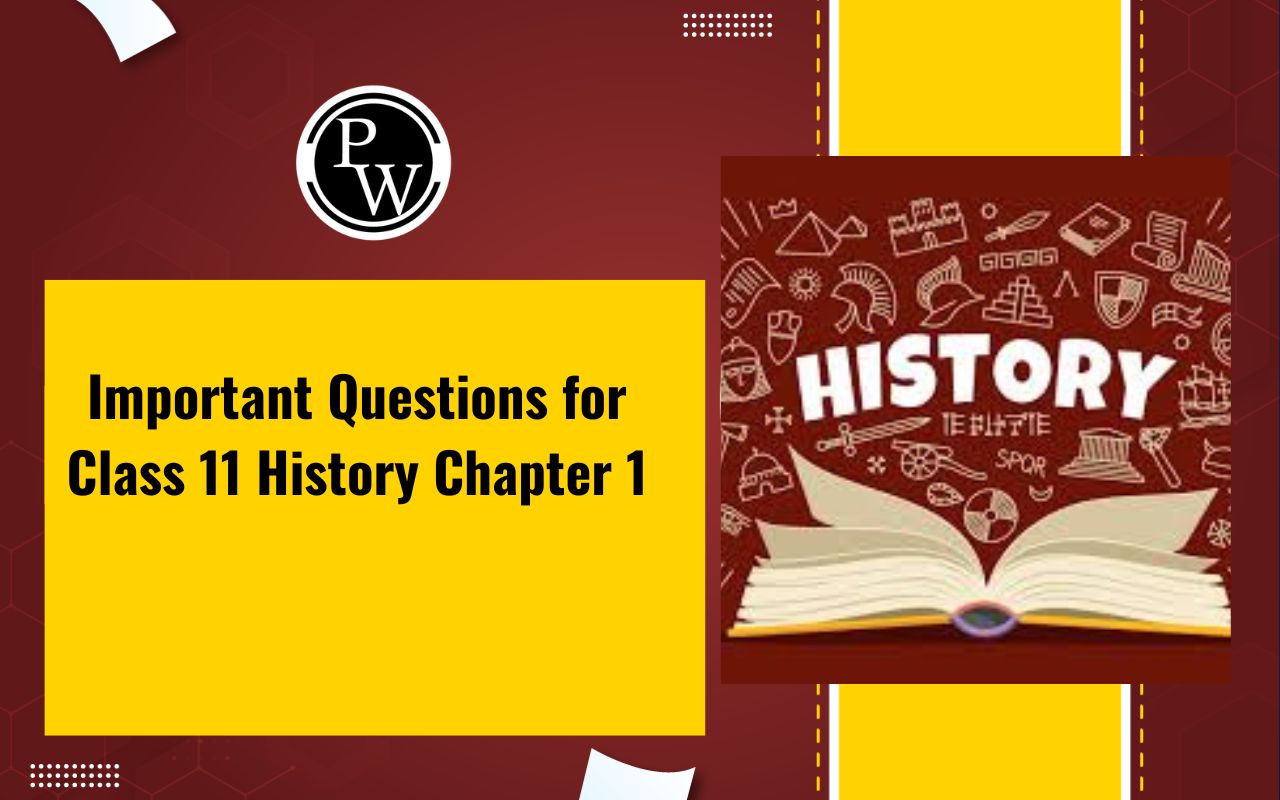

Important Questions for Class 11 History Chapter 1: Here are some important questions for Class 11 History Chapter 1 Writing and City Life which can be beneficial for students preparing for their exams.
By focusing on these questions students can gain a clear understanding of how writing influenced communication, record-keeping and administration in ancient cities. Solving these questions will help students prepare for exams by highlighting key concepts that show the connection between writing and the growth of complex urban life.Important Questions for Class 11 History Chapter 1 Overview
These important questions for Class 11 History Chapter 1 Writing and City Life have been created by subject experts at Physics Wallah. By studying these questions, students can gain a strong understanding of how writing transformed communication and administration, leading to the growth of complex societies. These questions are created to help students prepare effectively for exams and to build a solid foundation in ancient history.Important Questions for Class 11 History Chapter 1 PDF
The PDF link for Important Questions for Class 11 History Chapter 1 is available below. This PDF includes a set of important questions that cover the essential topics from the chapter, such as the origins of writing, the growth of early cities, and the impact of these developments on ancient societies. Downloading this PDF will provide students with focused guidance, making exam preparation easier and more effective.Important Questions for Class 11 History Chapter 1 PDF
Important Questions for Class 11 History Chapter 1 Writing and City Life
Here is the Important Questions for Class 11 History Chapter 1 Writing and City Life-Question 1: What do you know about Uruk?
Answer:
Uruk was an ancient city located on the banks of the Euphrates River in Mesopotamia, around 2500 kilometers southeast of modern Baghdad. It was founded around 3000 BCE and became one of the largest cities of its time, spreading over an area of 250 hectares. By 2800 BCE, the city expanded to 400 hectares, with a population between 50,000 and 80,000 people. Uruk was known for its impressive architecture and technological advancements, such as the invention of the potter’s wheel. The city's ruler, King Gilgamesh, is famous for making Uruk a powerful capital.Question 2: Describe the main features of the city of Babylon.
Answer:
Babylon was a major city in ancient Mesopotamia, located along the Tigris River. It became prominent under the rule of King Hammurabi and later reached its peak under King Nabopolassar. Babylon had magnificent features like a triple wall surrounding the city for protection. The Ziggurat, a large temple, was one of its main attractions. The city was also a center for commerce, and it made significant progress in language, literature, science, and medicine.Question 3: Describe the nature of early urban society in Mesopotamia.
Answer:
Early Mesopotamian society was divided into three classes. The first class included kings, priests, rich merchants, and high military officers. They lived luxuriously, in large homes with servants. The second class was made up of small-scale merchants, artisans, and intellectuals. The lowest class consisted of laborers and slaves who had to work for the upper classes. There was a significant disparity between these groups, with the wealthier classes being buried with precious items, while common people were buried with simple objects.Question 4: How did the construction of temples and the activities around them evolve in Mesopotamia?
Answer:
Temples in Mesopotamia were initially small and made of unbaked bricks, but over time, they became larger and more important. They were built on hilltops as people believed the gods resided there. The temples were centers of worship, education, and economic activity. They became involved in trade, offering loans, and managing land for production. Temples also served as centers of social interaction and entertainment.Question 5: What do you know about the Epic of Gilgamesh?
Answer:
The Epic of Gilgamesh is one of the oldest known pieces of literature, written about the ruler of Uruk, Gilgamesh, who lived around 2700 BCE. The epic tells the story of Gilgamesh’s adventures, including his friendship with Enkidu, a wild man created by the gods to challenge him. Together, they defeat the demon Humbaba and face many trials. After Enkidu’s death, Gilgamesh searches for immortality but learns that it is not achievable. The epic highlights the themes of friendship, mortality, and the search for meaning in life.Question 6: Compare the Indus Valley Civilization with the Mesopotamian Civilization.
Answer:
Both the Indus Valley and Mesopotamian civilizations developed along river valleys — the Indus and the Tigris-Euphrates. Both civilizations are known for their advanced town planning. However, Mesopotamian towns were often less organized compared to the well-planned cities of the Indus Valley. The Mesopotamians used narrow streets, while the Indus Valley cities had wide, straight streets. The drainage system in the Indus Valley was more advanced than that of Mesopotamia.Question 7: What do you know about the palace at Mari of King Zimrilim?
Answer:
The Great Palace of Mari was the royal residence of King Zimrilim. It was a large and impressive structure with over 260 rooms and spread across 2.4 hectares. The palace was also the center of administration and had beautiful wall paintings. It had a courtyard, and the king would meet foreign delegates in the palace, offering them food and hospitality. This palace was one of the most famous buildings of its time.Question 8: Why were there often clashes between the animal herders and farmers of Mari?
Answer:
Clashes occurred between animal herders and farmers in Mari due to competition for land and water. Shepherds often took their herds through farmland, damaging crops. Farmers also blocked the herders' access to water sources, causing conflicts. Over time, some herders began to settle down and take up farming, which further strained their relationship with the agricultural communities.Question 9: How did the amalgamation of different castes and communities give birth to a new civilization in Mari?
Answer:
The city of Mari became a melting pot of different communities, including Akkadians, Amorites, and others. The people in Mari had different cultures, dress codes, and traditions. This blending of various groups led to the rise of a new civilization, with a mix of agricultural and pastoral lifestyles. The king of Mari built a magnificent temple to the god Dagan, showcasing the cultural fusion within the city.Question 10: How did the script of Mesopotamia help historians understand its civilization?
Answer:
Mesopotamian scripts, such as Sumerian and Akkadian, played a important role in preserving the history and culture of the region. The script helped historians understand ancient Mesopotamian society, politics, religion, and daily life. Though literacy was not widespread and the script was complex, the deciphering of Mesopotamian texts has been essential in uncovering the history of this ancient civilization.Benefits of Solving Important Questions for Class 11 History Chapter 1
Solving important questions for Class 11 History Chapter 1 provide several key benefits for students preparing for exams:Strengthening Conceptual Understanding : By solving a variety of important questions, students can deepen their understanding of key historical concepts, events, and developments. It helps them to connect facts with broader historical themes and concepts, making the subject more meaningful and engaging.
Improved Retention : Repeatedly solving questions reinforces memory and ensures that students retain the information better. This is particularly important for subjects like history, which require memorization of dates, events, and figures.
Enhancing Analytical Skills : Many important questions require students to analyze historical events, causes, and effects. This not only sharpens their critical thinking but also helps in understanding the complexities of history beyond simple facts.
Better Time Management : Regular practice with important questions helps students get accustomed to the exam format and time constraints. This enables them to manage their time more effectively during the actual exam.
Familiarity with Exam Patterns : Solving important questions gives students insight into the types of questions that may appear on the exam. It also allows them to identify the areas that are often emphasized by examiners, helping them focus on the most relevant content.
Increased Confidence : As students solve more questions, they build confidence in their ability to tackle the subject. This confidence is essential during exams, as it reduces anxiety and helps students perform better.
Comprehensive Revision : Important questions cover a wide range of topics within a chapter. Solving them allows students to revise multiple aspects of the chapter at once, ensuring that they are well-prepared for the exam.
Effective Assessment of Knowledge : By solving important questions, students can assess their own understanding of the chapter. If they struggle with any question, it highlights areas where they need to focus more, allowing for targeted revision.
Improved Writing Skills : Answering questions effectively helps students improve their writing skills, particularly in structuring answers in a clear, concise, and organized manner an essential skill for history exams.
Boosts Performance in Exams : Consistent practice with important questions increases the likelihood of performing well in exams. As students familiarize themselves with the expected answer format and content, they become better equipped to score higher marks.
Important Questions for Class 11 History Chapter 1 FAQs
What is the significance of writing in city life?
How did writing contribute to the growth of urban centers?
What role did scribes play in ancient city life?
How did city life evolve with the advent of writing?












